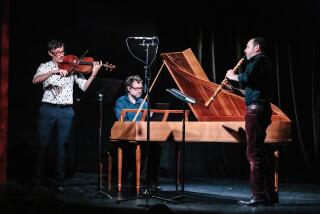MUSIC IN HISTORIC SITES : CAMERATA KOELN PLAYS IN CHURCH
Chamber music has many faces, and many locales, in Los Angeles. The most interesting in many ways have been discovered by the enterprising MaryAnn Bonino and her Da Camera Society, which sponsors a series called Chamber Music in Historic Sites.
In the past, Bonino and friends have plied their mellifluous and emphatically successful trade in hilltop mansions, Deco showplaces, ornate lobbies, picturesque living rooms, private salons, at various landmarks on Catalina Island, even at the carrousel on the Santa Monica pier.
The searching impresaria always attempts somehow to link places and sounds. According to officially stated policy, “Chamber Music in Historic Sites travels to a variety of unique and intimate environments to celebrate the experience of music in a social and architectural context.”
Unfortunately, it doesn’t always work.
Wednesday night, for instance, Bonino--with help from the Goethe Institute Los Angeles--was able to play host to the Camerata Koeln. This is a remarkably sophisticated, vital, scholarly ensemble from Cologne that happens to specialize in the intricate refinements of the Baroque.
Los Angeles, unfortunately, doesn’t happen to have many appropriate settings for this sort of music-making. Eighteenth-Century castles and exquisite chapels of the period in question are in rather short supply here. The stylish West German ensemble might seem less than comfortable, moreover, were it to perform at a merry-go-round or in a decadent old movie house.
Bonino opted, possibly by default, for the social and architectural context of the First Christian Church in Santa Monica. It didn’t turn out to be an auspicious choice.
Designed by Robert H. Orr in 1924, the modest, no-nonsense brick structure at 609 Arizona Ave. combines quasi-neo-classic banality with a few slick-semi-Deco trimmings plus traces of cheap ecclesiastical glitz.
The flat-pink and pastel-blue walls, kitschy stained-glass windows and electric-light cross looming behind the altar could do little to complement the elegant music of Telemann, Marin Marais, Vivaldi, Corelli and Bach that comprised the program. (Even with a program, incidentally, it was difficult to figure out what was being played and by whom.)
The wooden pews, moreover, proved unkind to the assembled Sitzfleisch . And the acoustics afforded maximum definition and balance only in the balcony.
Under the circumstances, one had to work hard to savor the subtle, somewhat monochromatic pleasures of the Cologne performances. The Santa Monica ambiance was, if anything, contradictory.
As is fashionable today in discerning circles, the Camerata plays old music on old instruments, or reasonable facsimiles thereof. The four resourceful musicians, moreover, are serious gentlemen who know and respect the ancient rules of embellishment and affect.
They perform with poise, crispness of articulation and high spirits even when inherent technical problems preclude absolute precision. Like all fine chamber musicians, they listen to each other with mutual sensitivity, matching nuance for nuance. Each member of the team knows exactly when to lead and when to follow.
The illustrious visitors savor constant, propulsive elan. They allow no room for sentimental indulgence, not even when climactic cadences beckon.
Michael Schneider plays the recorder and, on occasion, the transverse flute with uncommon purity of tone and with breath that knows no limits.
Hans-Peter Westermann coaxes sensuous, remarkably flexible sounds out of his antique oboe.
Rainer Zipperling masters both the Baroque cello and viola da gamba with hearty panache.
Harald Hoeren provides muted continuo support at the harpsichord where necessary but demonstrates real bravura authority in the solo flourishes of the Bach Chromatic Fantasy and Fugue.
It would be nice, someday, to experience the Camerata Koeln amid flickering candles in some pristine 250-year-old church, or in some aristocratic Rococo salon. Or, failing that, in a bona-fide concert hall.
More to Read
The biggest entertainment stories
Get our big stories about Hollywood, film, television, music, arts, culture and more right in your inbox as soon as they publish.
You may occasionally receive promotional content from the Los Angeles Times.










